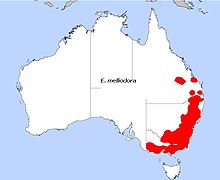Eucalyptus melliodora
| Yellow box | |
|---|---|

| |
| Eucalyptus melliodora, flowers & leaves | |
| Scientific classification | |
| Kingdom: | Plantae |
| Clade: | Tracheophytes |
| Clade: | Angiosperms |
| Clade: | Eudicots |
| Clade: | Rosids |
| Order: | Myrtales |
| Family: | Myrtaceae |
| Genus: | Eucalyptus |
| Species: | E. melliodora |
| Binomial name | |
| Eucalyptus melliodora | |

| |
| E. melliodora, field distribution | |
Eucalyptus melliodora, commonly known as yellow box, honey box or yellow ironbark,[3] is a species of medium-sized to occasionally tall tree that is endemic to south-eastern, continental Australia. It has rough, flaky or fibrous bark on part or all of the trunk, smooth greyish to yellowish bark above. The adult leaves are lance-shaped to egg-shaped, the flower buds are arranged in groups of seven and the fruit is more or less hemispherical.
Description
Eucalyptus melliodora is a tree that typically grows to a height of 30 m (98 ft) and forms a lignotuber. The bark is variable ranging from smooth with an irregular, short stocking, to covering most of the trunk, fibrous, dense or loosely held, grey, yellow or red-brown, occasionally very coarse, thick, dark brown to black. The smooth bark above is shed from the upper limbs to leave a smooth, white or yellowish surface. Young plants and coppice regrowth have lance-shaped to elliptic leaves that are 25–65 mm (0.98–2.56 in) long and 9–35 mm (0.35–1.38 in) wide and petiolate. Adult leaves are the same dull light green or slate grey on both surfaces, lance-shaped to egg-shaped, 60–140 mm (2.4–5.5 in) long and 8–30 mm (0.31–1.18 in) wide on a petiole 8–20 mm (0.31–0.79 in) long. The vein on the leaf margin of both adult and juvenile leaves is markedly distant from the leaf margin.[3][4][5]
The flower buds are arranged in groups of seven on an unbranched peduncle 3–10 mm (0.12–0.39 in) long, the individual buds on pedicels 2–10 mm (0.079–0.394 in) long. Mature buds are club-shaped, oval or diamond-shaped, 4–8 mm (0.16–0.31 in) long and 3–5 mm (0.12–0.20 in) wide with a conical to rounded operculum. Flowering has been recorded in most months and the flowers are white. The fruit is a woody, hemispherical to shortened spherical capsule 3–8 mm (0.12–0.31 in) long and 3–7 mm (0.12–0.28 in) wide with the fruit near or below rim level.[3][4]
Taxonomy
Eucalyptus melliodora was first formally described in 1843 by Johannes Conrad Schauer from an unpublished description by Allan Cunningham and the description was published in Walpers' book Repertorium Botanices Systematicae.[6][7] The specific epithet (melliodora) is derived from the Latin words melleus meaning "honey" and odorus "scented".[3]
Distribution and habitat
Yellow box is widely distributed on the eastern plains and tablelands from western Victoria, New South Wales and up from the capital territory to south-central Queensland.[8]
Ecology
It is associated with inland grey box, fuzzy box (E. conica), white box (E. albens), pilliga grey box (E. pilligaensis), red ironbark (E. sideroxylon), narrow-leaved ironbark (E. crebra), Blakely's red gum (E. blakelyi), apple species (Angophora), black cypress (Callitris endlicheri), white cypress (Callitris glaucophylla), kurrajong (Brachychiton populneus) and wattles (Acacia) species.[9]
Uses
Eucalyptus melliodora provides good firewood and hard, strong, durable timber. The honey produced from it is renowned for its quality.[10]
Notable specimens
One of the few trees to survive the blast from the 6 August 1945 atomic bombing of Hiroshima Japan, was an E. melliodora. The tree was located 740 m (2,430 ft) from the hypocenter, and as of April 2019 was still standing.[11]
Gallery
- E. melliodora in Wagga Wagga
- leaf
- leaves
- flowers and flower buds
- fruit
- trunk detail
- flowers
References
- ^ Fensham, R.; Laffineur, B.; Collingwood, T. (2019). "Eucalyptus melliodora". IUCN Red List of Threatened Species. 2019: e.T61913766A61913768. doi:10.2305/IUCN.UK.2019-3.RLTS.T61913766A61913768.en. Retrieved 27 October 2021.
- ^ "Eucalyptus melliodora". Australian Plant Census. Retrieved 3 November 2019.
- ^ a b c d "Eucalyptus melliodora". Euclid: Centre for Australian National Biodiversity Research. Retrieved 31 May 2020.
- ^ a b Chippendale, George M. "Eucalyptus melliodora". Australian Biological Resources Study, Department of the Environment and Energy, Canberra. Retrieved 3 November 2019.
- ^ Brooker & Kleinig, Eucalyptus, An illustrated guide to identification, Reed Books, Melbourne, 1996
- ^ "Eucalyptus melliodora". APNI. Retrieved 3 November 2019.
- ^ Schauer, Johannes Conrad (1843). Walpers, Wilhelm Gerhard (ed.). Repertorium Botanices Systematicae (Volume 2). New York. p. 924. Retrieved 3 November 2019.
- ^ Costermans, L.F. (1981). Trees of Victoria. Melbourne: Author. ISBN 0-9599105-1-4.
- ^ Boland, Douglas J.; Brooker, M. Ian H.; Chippendale, G. M.; McDonald, Maurice W. (2006). Forest trees of Australia. Collingwood, Victoria: CSIRO Publishing. p. 464. ISBN 0-643-06969-0.
- ^ Kelly, Stan; Chippendale, George M.; Johnston, R.D. Eucalypts. Vol. 1. p. 65. ISBN 0170062570.
- ^ "Database of Hibaku Jumoku ― Atomic-Bombed Trees of Hiroshima" (PDF). United Nations Institute for Training and Research. Retrieved 27 May 2020.
Further reading
- Bootle KR. (1983). Wood in Australia. Types, properties and uses. McGraw-Hill Book Company, Sydney. ISBN 0-07-451047-9







